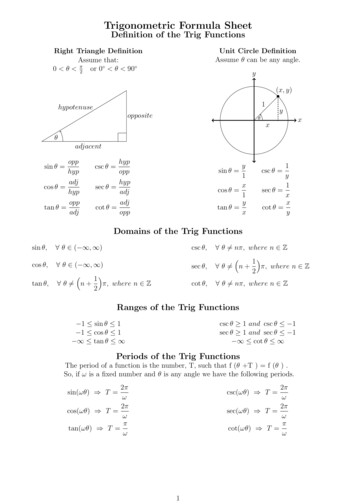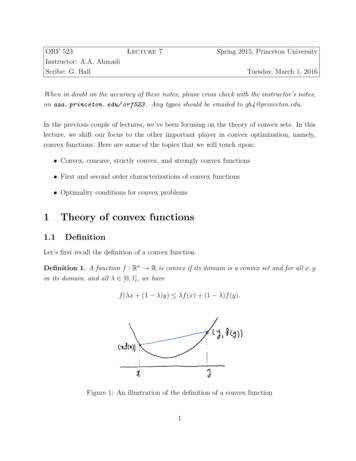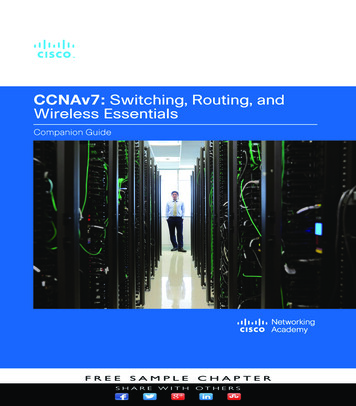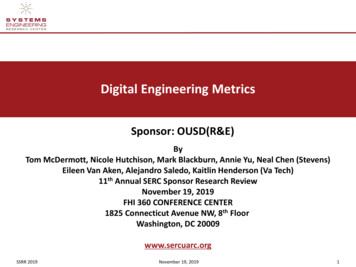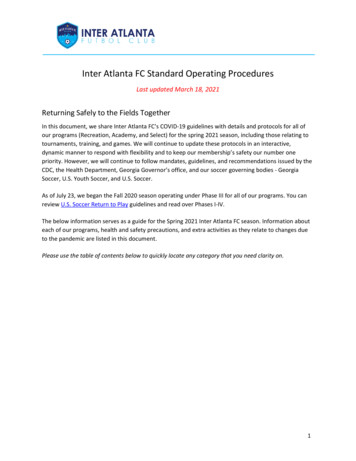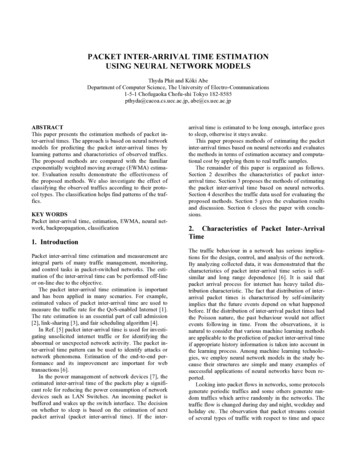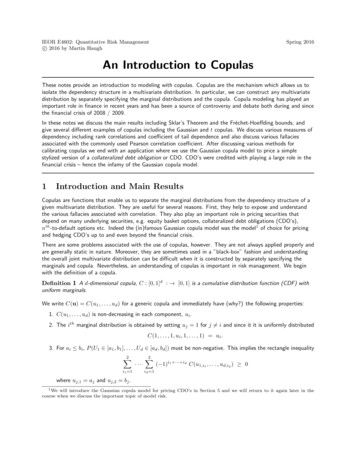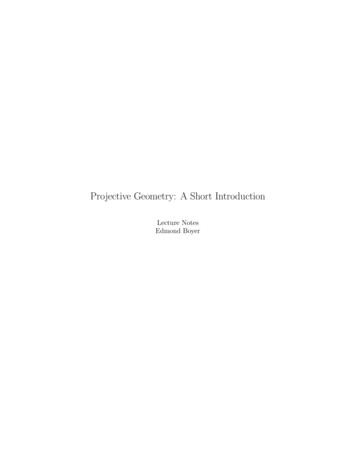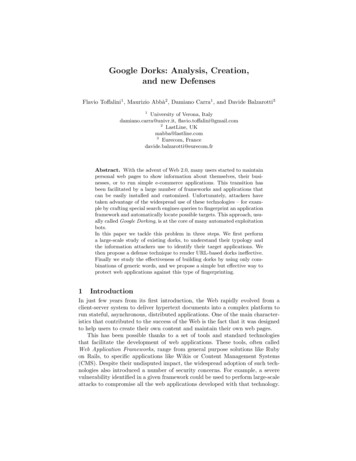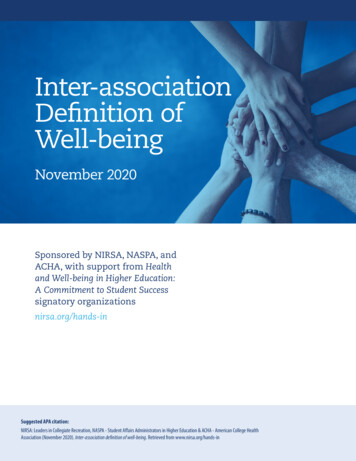
Transcription
Inter-associationDefinition ofWell-beingNovember 2020Sponsored by NIRSA, NASPA, andACHA, with support from Healthand Well‑being in Higher Education:A Commitment to Student Successsignatory organizationsnirsa.org/hands-inSuggested APA citation:NIRSA: Leaders in Collegiate Recreation, NASPA - Student Affairs Administrators in Higher Education & ACHA - American College HealthAssociation (November 2020). Inter-association definition of well-being. Retrieved from www.nirsa.org/hands-in
PAGE 2Inter-association Definition of Well-beingPurpose & BackgroundHealth and Well-being in Higher Education:A Commitment to Student Success commits toinnovating, supporting, and fostering a holistic,integrated, and strategic approach to well-beingfrom the association level to the institutionallevel. In our pursuit to co-create cultures ofintegrated well-being on campuses worldwide,we want to ensure we are building from a sharedunderstanding and foundation. Since there wasnot an existing definition that defined well-being,especially as it applies to higher education, themembers of our organizations asked that one becreated.To this end, we have worked together — as acommunity of experts from across our respectivefields — to review the many existing wellbeing theories and to adapt those theoriesand language into an overarching definition ofwell-being for higher education. This definition,and its supplementary material, is meant to befoundational; we hope a shared understandingcan be a stepping stone to systemic change.This document is, of course, not exhaustive,and it does not intend to mean all things to allorganizations or specialty areas; rather, the goalis to be widely usable. Our definition is tailoredto inform programming, policies, and practicesin support of well-being in higher educationsettings. Additionally, we acknowledge thatwell-being is not solely a place-based concept. Anopportunity exists for us to consider well-beingmore broadly in a plurality of higher educationcontexts, including the online environment. Inthis manner, connectedness to the institutionis an overarching sense that students take withthem wherever they go.Simple definitionWe define well-being as an optimal and dynamicstate that allows people to achieve theirfull potential.Expanded definitionwww.nirsa.org/hands-in110 5010 20003-201125We define well-being as an optimal and dynamic state that allows people to achieve their fullpotential. Our focus is on two interdependent types of well-being: 1) individual and 2) community.Individual well-being is defined within three broad and interrelated categories: (a) the perceivedassessment of one’s own life as being generally happy and satisfying, (b) having one’s human rightsand needs met, and (c) one’s contribution to the community. Community well-being is defined byrelationships and connectedness, perceived quality of life for all people in the community, and howwell the community meets the needs of all members. By focusing on the whole — the whole person, thewhole educational experience, the whole institution, the whole community — well-being becomes amultifaceted goal and a shared responsibility for the entire institution.
PAGE 3Inter-association Definition of Well-beingIndividual well-beingCommunity well-beingIndividual well-being is more explicitly defined bythree interrelated components – subjective wellbeing, objective well-being, and civic well-being.Table 1 presents the definitional and contributingfactors by individual well-being component.Community well-being is similarly defined bytwo interrelated components – subjective wellbeing and objective well-being. Although acommunity cannot be well if its members are notwell, community well-being mainly refers to thestructures, systems, and normative behavior ofthe community rather than the sum of individualwell-being. Individuals striving for well-beingneed communities of well-being to engage fullyin this pursuit. Table 2 presents the definitionaland contributing factors by community well-beingcomponent.2. Objective well-being is realized when peoplehave their basic human rights and needsmet. Objective wellbeing includes but is notlimited to: sufficient resources such as food,housing, safety, and physical/mental healthcare; experiences of systemic equity anddiversity; experiences of liberty and freedomof participation at all levels of society; andexperiences of unfettered human rights suchas freedom of speech, voting access, andjustice system protections.3. Civic well-being is demonstrated by actingon community-supportive values andcontributing to the communities in whichthey live. These communities may includeinstitution, local, state, national, and globalcommunities. Recognizing their own valueand impact on the whole community, theyactively participate in at least one behaviorthat benefits others. Additionally, they rejectbiased and prejudicial beliefs, and workwithin communities that are anti-racist andestablished to address and overcome socialinjustice. In other words, they act in supportof the subjective and objective well-being ofothers, rather than detracting from it.www.nirsa.org/hands-in1. Subjective community well-being isa collective perception expressed bygroups of people regarding their sharedsense of community and satisfactionwith community life. Additionally, peopleperceive that the overall quality of life isgood and just for all community membersregardless of differences across individualidentities.2. Objective community well-being is anexternally verifiable measure of thestructures, systems, practices, values,and normative behaviors that contributeto sufficient and equitable opportunities,resources, conditions, and other socioecological factors that make a particularcommunity setting more conductive to theachievement of full potential beyond whatis possible for a single individual. It is alsoimportant to recognize that institutions ofhigher education are embedded in a largersociety and are dependent on the well-beingof the ecosystems of the planet.110 5010 20003-2011251. Subjective well-being is expressed whenpeople feel good and think their livesare good; they would rank themselveshigh on measures of happiness and lifesatisfaction and low on measures of negativemood. The affective (e.g., feeling good)and cognitive (e.g., thinking life is good)aspects of subjective well-being can moveindependently from one another.
PAGE 4Inter-association Definition of Well-beingTable 1. Definitional and Contributing Factors by Individual Well-Being ComponentSubjectiveDefinitional FactorsContributing Factors:What are the necessary skills, resources,and conditions?Feeling happyHealthy coping and stress management skillsLife satisfactionOptimismSelf-esteemAppropriate/healthy skepticismFeeling hopeful/contentMeaningFeeling calm/at peacePurposeLimited experience of negative moodsBelongingEngagement in activities and academicsSocial support networksAchievementMasterySupportive campus norms, policies,practices, resources, and spacesFaculty and staff who design curriculum andprograms with these factors in mindFaculty and staff who model these factorsObjectiveSufficient resources such as food, housing,safety, and physical/mental health careExperiences of systemic equity and diversitySupportive campus norms, policies,practices, and resources (see CommunityWell-being)Experiences of liberty and freedom ofparticipation at all levels of societyExperiences of unfettered human rights suchas freedom of speech, voting access, andjustice system protections.CivicValuing doing good for othersValuing political engagementValuing humanitarian rightsValuing volunteeringBeing connected to others regardless ofidentityEngaging in political activismSupportive campus norms, policies,practices, and resourcesFaculty and staff who teach about thesethingsFaculty and staff who model these thingsSchool-supported opportunities to engagecivicallyEngaging in ds-in110 5010 20003-201125Valuing well-being for yourself and others
PAGE 5Inter-association Definition of Well-beingTable 2. Definitional and Contributing Factors by Community Well-Being ComponentSubjectiveDefinitional FactorsContributing Factors:What are the necessary skills, resources,and conditions?EquityRespect, fairness, and justice for allSense of communityEqual opportunity to achieve full potentialCollective efficacyResilience and empowermentSocial capitalInterpersonal relationshipsPlace and planetShared emotional connectionSatisfaction with the communityShared sense of identityBelongingInfluenceTrustCooperation, co-creation, and reciprocityIntegration and fulfillment of needsLeadership of beneficence, integrity,competence, and visionSatisfaction with the institutionInstitutional prideObjectiveSafetySupportive policies, practices, and normsAccessible, secure sources of food andhousingSupportive campus expectations and normsAccessible health-supporting servicesAccessible culture and artsAccessible recreation and leisureopportunitiesSystemic equitySystemic diversityLiberty and freedom of participation at alllevels of societyUnfettered human rightsSufficient resources and allocation ofresources on campusFair and equitable distribution of resourceson campusAvailable helping relationshipsProcedures and practices that facilitate senseof community, relationships, and socialconnection“Green spaces” and good air qualityBiophilic designEnvironmental quality and .org/hands-in110 5010 20003-201125Infrastructure/buildings
PAGE 6Inter-association Definition of Well-beingReferencesThe definitional and contributing factors were drawn from established frameworks/research/measures of wellbeing. We include some of those references below inalphabetical order.Centers for Disease Control and Prevention (31 October, 2018). Healthrelated quality of life: Well-being concepts. https://www.cdc.gov/hrqol/wellbeing.htmChavis, D. M., Lee, K. S., & Acosta J.D. (2008). The Sense of Community (SCI)Revised: The Reliability and Validity of the SCI-2. Paper presented at the2nd International Community Psychology Conference, Lisboa, 16819295377e5a979b1893.pdfDiener, E. (1984). Subjective well-being. Psychological Bulletin, 95(3), 542575. doi: 10.1037/0033-2909.95.3.542Diener, E., Wirtz, D., Tov, W., Kim-Prieto, C., Choi, D., Oishi, S., & BiswasDiener, R. (2009). New measures of well-being: Flourishing and positiveand negative feelings. Social Indicators Research, 39, 247-266.Gallup, Inc. (2016). Gallup-Purdue Index report: Great Jobs. Great lives. Thevalue of career services, inclusive experiences and mentorship for collegegraduates. ueindex-report-2016.aspxHarward, D. (Ed.) (2016). Well-being and higher education: A strategy forchange and the realization of education’s higher purpose. BringingTheory to Practice. https://bttop.org/publications/International Conference on Health Promoting Universities & Colleges(7th : 2015 : Kelowna, (B.C.)). Okanagan Charter: An internationalcharter for health promoting universities and colleges. ubc.ca/files/2016/01/Okanagan-Charter- January13v2.pdfJayawickreme, E., Forgeard, M. J. C., & Selgiman, M. E. P. (2012). The engineof well-being. Review of General Psychology, 16(4), 327-342. doi:10.1037/a0027990Keyes, C. L. M. (2002). The mental health continuum: From languishing toflourishing in life. Journal of Health and Social Behavior, 43(2), nKim, Y., & Ludwigs, K. (2017). Measuring community well-being andindividual well-being for public policy: The case of the communitywell-being atlas. In R. Phillips & C. Wong (Eds.) Handbook of communitywell-being research. Springer. doi: 10.1007/978-94-024-0878-2 22Nussbaum, M. (2011). Creating capabilities: The human developmentapproach. Harvard University Press.Robert Wood Johnson Foundation (2020). Enhanced individual andcommunity well-being. mlRyan, R. M., & Deci, E. L. (2001). On happiness and human potentials: Areview of research on hedonic and eudaimonic well-being. AnnualReview of Psychology, 52, 141-166. doi: 10.1146/annurev.psych.52.1.141Seligman, M. E. P. (2011). Flourish. The Free Press.Sen, A. (1999). Development as freedom. Oxford University Press.Su, R., Tay, L., & Diener, E. (2014). The development and validation ofComprehensive Inventory of Thriving (CIT) and Brief Inventory ofThriving (BIT). Applied Psychology: Health and Well-Being. Publishedonline before print. doi: 10.1111/aphw.12027Sung, H., Phillips, R.G. (2018). Indicators and Community Well-Being:Exploring a Relational Framework. International Journal of CommunityWell-being, 1, 63–79. doi: 10.1007/s42413-018-0006-0The Santa Monica Office of Civic Wellbeing (2015). The Wellbeing eing-indexUnterhalter, E. (2009). What is equity in education? Reflections from thecapability approach. Studies in Philosophy and Education, 28(5), 415424. doi: 10.1007/s11217-009-9125-7VanderWeele, T.J. (2019). Measures of community well-being: A template.International Journal of Community Well-being, 2, 253-275. doi: 10.1007/s42413-019-00036-8Wellbeing Assessment (2020). Wake Forest University. ng-assessment/World Health Organization (2020). Basic documents: Forty-ninth edition(including amendments adopted up to 31 May 2019). Geneva: WorldHealth Organization; 2020. Licence: CC BY-NC-SA 3.0 IGO. 10 5010 20003-201125Abrams, G. B., Andes, S., DeRicco, B., Rider-Milkovich, H., & Wilcox, D. (2018).CAS cross-functional framework for advancing health and well-being.(P. J. Caretta, Ed., & L. Dahl, GD). Washington, DC: Council for theAdvancement of Standards of Higher Education. https://www.cas.edu/store product.asp?prodid 154
Inter-association Definition of Well-being November 2020 Suggested APA citation: NIRSA: Leaders in Collegiate Recreation, NASPA - Student Affairs Administrators in Higher Education & ACHA - American College Health
